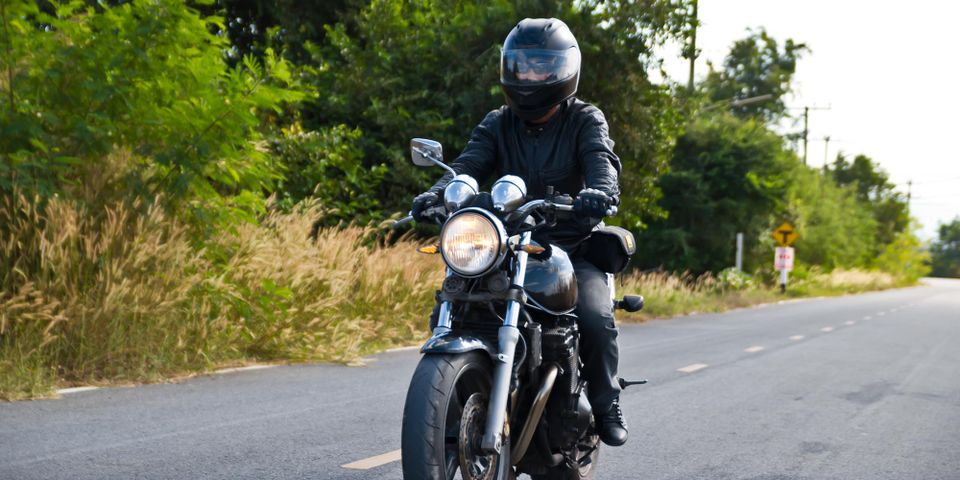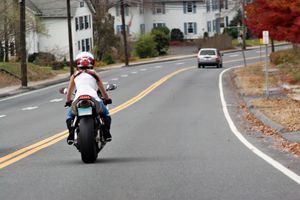
Driving near a motorcycle presents an added complication to road safety. These compact, two-wheeled vehicles ride without the protection of an airbag-equipped cab surrounding them, and they require a completely different set of skills to operate. To assure that everyone stays safe on the road, rain or shine, it’s essential that you understand the risks these motorcyclists face as well as how to avoid a car crash with one.
Dangers of Riding a Motorcycle by the Numbers
In a Collision
Motorcycle riders are inherently at more risk on the road, which requires you and other drivers to act more vigilantly around them. For perspective, a motorcyclist is 26 times more likely to die in a car crash and five times more likely to be injured than you are in a car. Since 1999, the fatality rate for motorcycle wrecks has more than doubled, with 5,286 motorcyclists killed in 2018. In two-thirds of these collisions, the car causes the incident by violating the motorcyclist’s right of way, namely in intersections.
While Wearing a Helmet
 While there isn’t a direct correlation for the cause of this increase in motorcycle vs. car crash fatalities, a key piece of safety gear has lost popularity in the past two decades. The U.S. Department of Transportation’s (DOT) stats on helmet usage have dropped from 71% in 2000 to 65% in 2017, falling as low as 48% in 2005. Only 19 states and the District of Columbia have universal helmet laws, while another 28 states have laws covering only those under 18. Illinois, Iowa, and New Hampshire are the only states with no helmet requirements. Nationwide, states with universal helmet laws have a 97% observance of these rules, while those without have only 48% observance.
While there isn’t a direct correlation for the cause of this increase in motorcycle vs. car crash fatalities, a key piece of safety gear has lost popularity in the past two decades. The U.S. Department of Transportation’s (DOT) stats on helmet usage have dropped from 71% in 2000 to 65% in 2017, falling as low as 48% in 2005. Only 19 states and the District of Columbia have universal helmet laws, while another 28 states have laws covering only those under 18. Illinois, Iowa, and New Hampshire are the only states with no helmet requirements. Nationwide, states with universal helmet laws have a 97% observance of these rules, while those without have only 48% observance.
When riders opt for a helmet, it can make a significant difference in a motorcycle crash. The National Highway Traffic Safety Administration (NHTSA) found that wearing a helmet can reduce the risk of dying in a car crash by 37%. When a rider doesn’t wear one, they are three times more likely to sustain a traumatic brain injury. The helmets that sufficiently protect a motorcyclist’s head must meet federal performance standards, which typically include full faceguards. In the U.S., the percentage of federal safety-compliant helmets on the road hovers at 87% in states with universal helmet laws and 44% in states that don’t have them.
With a Motorcycle License & Course
All states will require a rider to have at least a supplemental motorcycle license in addition to a driver’s license, but not all of them include a defensive riding course, which can teach a new motorcyclist valuable tactics to use on the road. Even with these bare minimum rules in place, in 2017, 29% of motorcyclists involved in fatal car crashes were riding without a valid motorcycle license. To keep motorcycles safe on the road, having both riders and you as an adjacent driver taking ample precaution can save lives.
Problems That Put Motorcyclists More at Risk
Visual Recognition
On the road, motorcycles take up less space, so they can be harder to spot as you’re driving, especially in poor visibility or at nighttime. This issue is heightened at intersections, where blind spots created by other vehicles can keep you from seeing a bike coming the other direction. Proceed with caution at an intersection, only making the turn when you are positive that you are not a hazard to yourself or others.
Road Hazards
A car’s suspension will take potholes and uneven pavement in stride so that you can have as smooth a ride as possible. While a motorcycle is employed with similar stability measures, these road hazards, along with oil slicks, puddles, and debris are less gracefully handled on two wheels, which forces motorcycles to navigate roadways in more of a weaving formation. Give bikes space to move around these common issues, as you won’t have much time to react when they spot a problem.
Lack of Skill or Gear
Motorcycles require more skill to drive because they factor balance into the equation. Plus, these vehicles have a quicker reaction time when accelerating, turning, or braking. If a new rider is untrained in how to operate a bike, it can be a recipe for a collision, especially when other drivers on the road are not keeping an eye out for potential mishaps. Besides skill, the gear riders wear also keeps them safe. Helmets, leather jackets, pants, and protective boots can save a motorcyclist’s life if a car crash occurs. Additional mechanisms like an anti-lock braking system (ABS) can also keep riders from experiencing a wheel lockup. This common issue can result in a severe fall, and motorcycles equipped with an ABS have a 31% lower frequency of it happening.
How to Safely Share the Road
Watch Your Blind Spots
Since motorcycles are more difficult to spot, drivers need to always proceed with caution when changing lanes or turning. Opting for a casual glance will not suffice for these compact vehicles, so always signal well ahead of your impending movement, check your mirrors sufficiently, and have a thorough look at your blind spots. These rules are particularly essential for big trucks or vans, whose blind spots are more extensive than most vehicles.
Give Them the Whole Lane
 A motorcycle will likely only take up a small part of a lane when on the road, but you should give them the same amount of space as a standard car—if not more. Never pass these bikes while riding in the same lane, and only pass them by switching lanes, as you would any other car. You should also give them extra following distance—especially in high-speed highway situations—because a common way that motorcyclists slow down is by downshifting instead of breaking. When that occurs, the brake lights will not engage, leaving you without a physical warning of a slowing pace. To keep clear of a potentially disastrous fender bender, offer three to four seconds of stopping time between you and a motorcycle.
A motorcycle will likely only take up a small part of a lane when on the road, but you should give them the same amount of space as a standard car—if not more. Never pass these bikes while riding in the same lane, and only pass them by switching lanes, as you would any other car. You should also give them extra following distance—especially in high-speed highway situations—because a common way that motorcyclists slow down is by downshifting instead of breaking. When that occurs, the brake lights will not engage, leaving you without a physical warning of a slowing pace. To keep clear of a potentially disastrous fender bender, offer three to four seconds of stopping time between you and a motorcycle.
Remain Vigilant in Bad Weather
Poor weather conditions pose two threats to a motorcyclist: poor visibility and drastically reduced traction. Since it’s already harder to spot these small targets on the road, when conditions become unideal, it becomes even harder to spot a motorcycle. Try to drive extra carefully in adverse road conditions to spare you a car crash with a bike. While tire tread can help with rain riding for vehicles, incorporating the balance element of motorcycles also makes them more prone to sliding and falling on puddles. High winds can also limit a rider’s control of their bike. Keep these issues in mind when following a motorcycle so that you can anticipate any problem that arises early enough to react.
Be Wary of Turn Signals
On the majority of cars nowadays, turn signals are “self-canceling,” meaning once you make your turn, the signal automatically shuts off. While this tool is available for motorcycles, a lot of bikes on the road today still don’t have a self-canceling mechanism. As a result, a rider can sometimes leave their turn signal on well after they’ve made their turn. If you see a rider with a turn signal on for an unreasonable length of time, keep a sharp eye on their movements and keep a distance so you can anticipate when they eventually do turn.
Practicing precaution around motorcycles can help avoid dangerous instances of negligence on the road. If the worst occurs on these bikes, though, you can seek financial compensation from the offending party with Salerno & Leavitt on your side. As the trusted name in car crash law in Omaha, NE, for over 30 years, our team’s trusted leader, Terrence J. Salerno and Danny C. Leavitt, will fight to get you the compensation you deserve. For more information about how our team of attorneys can assist in your case, visit our website or give us a call today at (866) 787-2598.
About the Business
Have a question? Ask the experts!
Send your question

